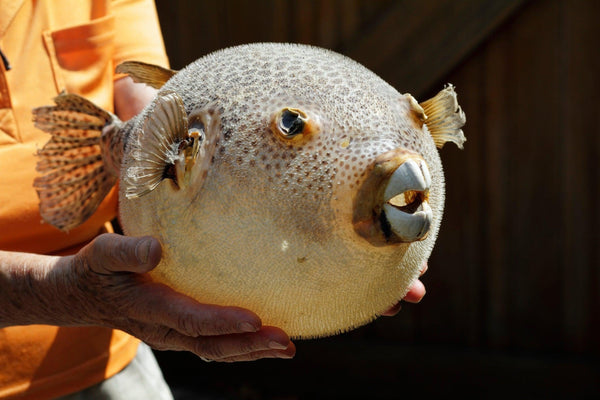
Jump to:
Among the mysterious, legendary, and often misunderstood foods of Japanese cuisine, fugu most certainly occupies a top perch.
Fugu fish, often simply known as fugu (pufferfish), is a complex Japanese delicacy. Fugu is savored with the knowledge that some of its organs contain a poison that is fatal if ingested. Revered for its unique flavor and texture, fugu presents a paradoxical appeal rooted in the thrill of culinary adventure and the appreciation for the work of Japanese master chefs.
The risks associated with consuming improperly prepared fugu are known worldwide, forging the fish's reputation as the most dangerous delicacy. Despite the potential peril, fugu is a gem in the Japanese culinary journey for food enthusiasts and culture explorers alike. Join us as we dive deep into the world of fugu, exploring what it is (and isn’t), its preparation techniques, and the cultural and culinary significance of fugu.
What Is Fugu? Why Is It So Legendary In Japanese Cuisine?

Fugu is a term used to represent a group of pufferfish species consumed as part of traditional Japanese cuisine. Over 120 species of pufferfish exist, though only a select handful are used in the preparation of fugu fish. Even the name “fugu” (ふぐ) is a testament to its prickly appearance, reminiscent of a bloated, spiky balloon when threatened.
Fugu fish are typically found in the warm seawater around Japan, where they feed on algae and various ocean-floor-dwelling creatures. Despite their seemingly unassuming nature and admittedly odd appearance, fugu harbor a deadly secret: they are one of the planet's most poisonous vertebrates.
Fugu venom, known as tetrodotoxin, is primarily stored in the fugu fish's liver and ovaries; yet traces of the poison can be found in the fugu pufferfish’s skin and other organs.
The allure of fugu lies not just within its potential danger but also in its distinct culinary qualities. When prepared correctly, fugu sashimi rewards the eater with a delicate, subtly sweet flavor and a unique chewy texture. The flavor profile is sometimes described as a cross between chicken and squid, yet it retains a uniqueness that sets it apart from any other seafood (or really, any food you’ve eaten before!).
Fugu is also prepared and served as a series of courses, some raw and some cooked. The restaurants that serve fugu fish in Japan must be licensed specifically to do so, and the master chef who cuts and cooks fugu brings many years of experience and knowledge of the safe and artful preparation of fugu. That’s why fugu is seen as “worth the risk,” in fact because the risk is statistically very low, while the reward is a fugu feast for the eyes and taste buds.
Why Is Fugu Pufferfish Dangerous?

The danger associated with fugu lies in a potent poison called tetrodotoxin.
This deadly substance – which is up to 1,200 times more potent than cyanide – is found primarily in fugu's liver and ovaries, with smaller amounts present in the intestines, skin, and even sometimes in its flesh.
Tetrodotoxin is a neurotoxin, meaning that it affects the nervous system. When ingested, fugu’s poison can cause a myriad of symptoms, including paralysis, dizziness, difficulty breathing and, in severe cases, heart failure. There is no known antidote for tetrodotoxin poisoning from fugu. Even more alarming is the fact that the toxin does not affect the taste or texture of the dish, which means it's difficult to detect until symptoms begin to show.
This makes the preparation of fugu a high-stakes affair, requiring a skilled hand and an intimate knowledge of the fish's anatomy. Any error could contaminate the otherwise safe flesh with the deadly toxin, leading to potentially lethal consequences. It’s understandable, then, that fugu has earned a reputation as the ultimate culinary gamble.
And yet, as dangerous as fugu might sound, it is consumed in the range of thousands of tons annually. Fugu isn’t a daily food in Japan, to be sure, but it is eaten at special occasions in specialty restaurants.
How Must Fugu Be Prepared In Order For It To Be Safe?

The preparation of fugu is an artform, a meticulously precise process that strives with every measure to safely extract the edible flesh while ensuring no cross-contamination occurs with the poisonous parts. So stringent are the safety measures involved that it has become a highly regulated gastronomic practice in Japan, with only licensed fugu chefs allowed to prepare and serve the pufferfish in their restaurants.
Typically, the 'Tora Fugu’ or tiger pufferfish, is used in creating fugu sashimi. This species is considered one of the tastier types, yet it's also known for its high tetrodotoxin levels. Starting from the careful catch to the final presentation, every step is a testament to the chef's skill and expertise.
The fugu chef starts by gutting the fish, removing the internal organs that contain the deadly toxin. Then the chef skins the fish because traces of the poison might be present. What remains is the edible meat, which must be cleaned thoroughly to eliminate any potential contamination.
The process doesn't end here, though. Fugu then needs to be sliced into extremely thin pieces. This is done in such a way that the customer can appreciate the skill involved in the preparation. The slices are so thin that they're almost transparent, and they're usually arranged in a beautiful pattern on the plate, further enhancing the fugu sashimi experience.
Ultimately, the preparation of fugu should not only ensure safety but also highlight the unique flavor and texture of the fish in its minimalistic glory, making it an unforgettably delicate eating experience.
What Qualifications Do Chefs Need To Have To Prepare Fugu In Japan?

Japan is, after all, a culture rather obsessed with safety. As a visitor to Japan, you’ll have the benefit of this in many facets of your journey. Not the least of these safety factors are seen in food preparation and service.
Fugu cuisine is a specialized skill – one that, if not implemented correctly, can have critical consequences. As such, the requirements to become a licensed fugu chef are among the strictest culinary certification processes in the world.
The career path to becoming a fugu chef begins with a rigorous apprenticeship under a master fugu chef, which traditionally lasts for at least two years. This includes theoretical and historical education regarding the different species of fugu fish and their levels of toxicity, as well as intensive practical training in safely preparing the fugu fish.
Following the apprenticeship, chefs must pass a comprehensive fugu licensing exam administered by Japan's Ministry Health, Labor and Welfare, or by a local public health center. The exam incorporates both a written and a practical component. The written test covers questions on fugu biology, different preparation methods, and emergency procedures for fugu poisoning. In the practical test, chefs must demonstrate their ability to correctly identify and safely prepare an actual fugu.
Only about 35% of chefs pass this rigorous exam on their first try, reflecting the high standards of the industry. Once certified, fugu chefs have the utmost responsibility to ensure the safety and satisfaction of their customers.
How Many People Die From Fugu Poison Every Year?
While records indicate that fugu-related deaths occur, they are, thankfully, increasingly rare due to stringent regulations put in place. In Japan, from 2000 to 2020, official statistics show an average of just over 6 deaths per year resulting from fugu poisoning. Most of these cases are attributed to the fish being prepared by non-certified individuals at home or purchased from unregulated sources.
Over the past several decades, the implementation of more rigorous training and licensing procedures for chefs – as well as a public awareness campaign about the dangers of consuming improperly prepared fugu – has significantly reduced the risk of fugu poisoning.
Nonetheless, it is worth noting that the effects of tetrodotoxin are rapid and lethal. Every year, there are also several reported cases of non-fatal fugu poisonings that necessitate emergency medical attention. These cases reinforce the importance of consuming fugu only in registered fugu restaurants where it is prepared by a certified chef.
Despite these risks, the thrill of fugu’s inherent danger and the uniqueness of its taste maintain its status as a desirable and prestigious dish.
What Are The Different Types Of Fugu?

Indeed, many different types of fugu exist, each with its unique characteristics. Of the 120 existing species of pufferfish, only a couple of dozen variants can be legally sold as fugu in Japan. These types vary in size, habitat, appearance – and in the level of toxicity.
The most prized of all fugu fish is the Tora Fugu or tiger pufferfish, known for its exceptional taste. Another popular species is the Mafugu or giant pufferfish, which is large and hence better for serving several people. Despite their differences, these variants all share the common trait that makes them a fugu – the presence of the powerful neurotoxin, Tetrodotoxin.
Mind you, not all pufferfish parts are dangerous. Most fugu dishes use the fish's safe parts – its flesh, fins, and (sometimes) the skin or membranes. However, there are regions in Japan, especially in fugu hot spots like Shimonoseki, where more risky parts like the liver (once considered the most delicious part of the fish) were served by certain licensed chefs, albeit with caution.
How Is Fugu Eaten In Japan? What Are The Different Styles?
Fugu is enjoyed in many ways in Japan, each style emphasizing the fish's unique texture and taste in its own manner. Though fugu sashimi is the most renowned method and is adored for its exceptional presentation, there are several other preparation styles cherished in Japan. Fugu fish is often served in courses, featuring some or all of the fugu course items listed below.
Fugu Sashimi

The sashimi, or Fugu Sashi, is sliced into thin, almost transparent pieces. Fugu sashimi is often served in a pattern that resembles a chrysanthemum, Japan's imperial flower. It is usually eaten with a dip consisting of soy sauce and citrus, like lemon or ponzu – to which finely sliced onions are often added, for an extra bite.
Fugu Karaage

Fugu Karaage is the Japanese style of deep-fried fugu. These golden, crispy fritters make excellent finger food, often served with a side of sake.
Fugu Nabe

Fugu Nabe, or hot pot fugu, is a popular winter dish where fugu chunks are slowly simmered with vegetables and tofu in a kombu (seaweed) broth. Once finished, the leftover savory broth is often mixed with rice or noodles, ensuring no flavors go to waste.
Yubiki Fugu

In the Yubiki style, fugu skin is blanched and served with a vinegar-based sauce, while Fugunuki invites diners to enjoy grilled skewered fugu without any condiments, celebrating the pure, unadulterated taste of the fish.
The versatility of fugu in Japanese cuisine demonstrates how this challenging ingredient can be skillfully manipulated to create a range of culinary experiences. As to the question regarding fugu’s flavor? Well, the answer lies in its delicate, subtly sweet taste and its unique texture.
History Of Fugu: Why Did People Start Eating It In the First Place?
The history of fugu consumption in Japan is fascinating, dating back several centuries. Some researchers suggest that the consumption of fugu, despite its lethal potential, began out of necessity during times of famine due to the abundance of the pufferfish species in Japanese waters.
The earliest known report of fugu consumption dates back to the Jōmon period (10,000–300 BC). During the Edo period (1603–1867), the consumption of fugu was more prevalent, although the government frequently issued bans due to its known risks. Despite regulations, people were drawn to fugu as an exotic delicacy, giving rise to a newfound industry focused on the fish's culinary potential.
Interestingly, the ban on fugu was temporarily lifted in the late 1880s due to an extreme shortage of other types of fish following a severe winter. This paved the way for fugu to become a wintertime culinary tradition, a practice that continues to this day.
When Is Fugu In Season In Japan?

Fugu season typically runs from October to March, with the peak occurring in the cold winter months, coinciding with the fish's fattening period. During this time, the liver and skin of the fish are believed to be at their tastiest, and the flesh has a firm texture, making it perfect for sashimi. This is why enjoying a steamy, hearty pot of fugu (fugu nabe) or thinly sliced fugu sashimi is a beloved winter activity in Japan.
It's worth noting that, although there's a designated season, due to modern refrigeration and aquaculture techniques, fugu can be enjoyed year-round. However, consuming fugu in season is a cherished tradition, and many argue that its taste is best during the winter months. To fully appreciate the cultural significance and culinary experience of fugu, it might be worth planning your fugu experience during this designated period.
Where Are The Best Places To Try Fugu In Japan?

If you're a food adventurer ready to try fugu, there are plenty of places in Japan well-regarded for this specialty. Be sure to choose a reputable restaurant with licensed chefs for a safe and authentic experience. Here are some excellent options:
We recently had the pleasure of dining at Tamafuku in Kobe, just outside Osaka. Tamafuku is a traditional fugu restaurant that has been in operation for decades. They offer a variety of fugu courses (as seen in the photos in this article), from sashimi to hot pot, all meticulously prepared by a master fugu chef who is passionate about sharing the world of fugu with his customers.
Like many modern fugu restaurants, Tamafuku doesn’t serve the fugu liver, opting to focus on the safest parts of the fugu pufferfish. Every course in our meal at Tamafuku was a star, with the fugu karaage (fried chicken style, but elevated on another level entirely) was perhaps the shining star in everyone’s opinion.
Genpin Fugu: A national chain of fugu eateries with several locations in Tokyo, Genpin Fugu is famous for serving a wide array of fugu dishes. Expect to find everything, from deep-fried fugu to fugu steamed with sake.
Fugu Fukuji: Situated in the gourmet hotspot of Ginza, Tokyo, Fugu Fukuji is a high-end restaurant specializing in fugu. They offer a multi-course meal of various fugu delicacies, with each dish beautifully presented.
The vaunted Michelin guide – which sees its highest concentration of Michelin-starred restaurants in this country above all others – also lists several fugu specialty restaurants.
Lastly, if you want to go where fugu is most famous, head to the city of Shimonoseki, often referred to as "Japan's Fugu Capital." Every year, more than 50% of Japan's fugu passes through Shimonoseki, and it's here you'll find top-rated fugu restaurants abound.
Remember that no matter where you choose to dine, consuming fugu is a respectful nod to a time-honored culinary tradition. Enjoy it responsibly, in the confines of a fugu specialty restaurant that has the skill and experience to serve it safely and most deliciously. Savor every bite and reflect on its significance as a unique dining experience.
Fugu: A Feast To Remember

Fugu, a legendary fish with a prickly exterior, encapsulates the essence of Japanese food culture. It’s a blend of aesthetic appreciation, uncompromising attention to detail, and a daring curiosity for unique flavors.
Despite its notorious reputation, venturing into the world of fugu fish promises an encounter with the heart and soul of Japan's culinary arts. From the precision involved in its preparation to the subtle nuances of its taste, fugu is more than just a meal; it is perhaps the single-most unique Japanese culinary experience.


0 comments